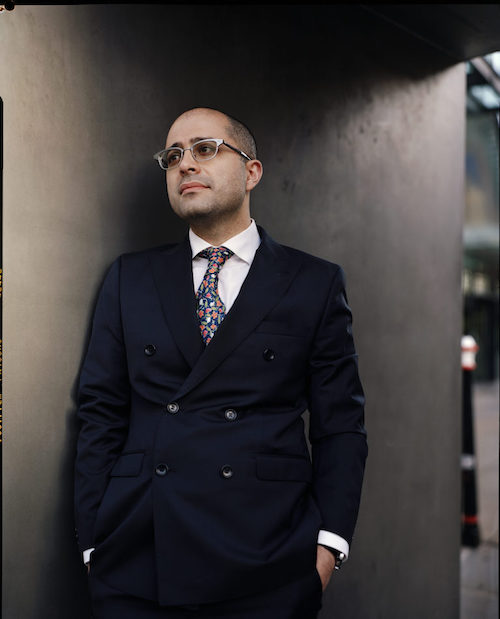Esfahani joins New World members for an array of modern harpsichord works

While the harpsichord is often associated with music of the Baroque and classical eras, the early keyboard instrument has also been utilized by many contemporary composers.
The New World Symphony devoted its final chamber music program of the year on Sunday afternoon to concerted harpsichord scores that spanned the eighteenth, twentieth and twenty-first centuries. Titled “Harpsichord Hero,” the concert was a brilliant showcase for Mahan Esfahani, one of today’s leading exponents of the instrument. The live but resonant acoustic of New World Center in Miami Beach proved a perfect fit for the forerunner of the piano, with the instrument’s sound clear and audible (not always the case in larger auditoriums).
CPE Bach’s Quartet in A minor for flute, viola, cello and harpsichord was a sprightly opener. Carl Philipp Emanuel was the most gifted of Johann Sebastian Bach’s composer sons and this three-movement score, dating from 1788, abounds in thematic invention and instrumental felicities.
The players’ leisurely tempo for the opening Andantino allowed each instrument’s line greater clarity. Esfahani’s dexterity at the keyboard was immediately evident. Violist Stephanie Block’s large sonority and musical precision gave the ensemble a firm underpinning. Flutist Leah Stevens’ role was pivotal. Her precision, which has been a strong component of many orchestral performances, was fully on display and she spun the Largo e sostenuto in long lyrical paragraphs. Chava Appiah’s bold cello strokes and Esfahani’s light touch highlighted the vigorous finale.
Born in Iran and trained in the United States and Prague (where he now resides), Esfahani illustrated his instrument’s versatility in Oophaa for harpsichord and percussion by Romanian-Greek avant-gardist Iannis Xenakis (1922-2001). In this work the harpsichord vies with unpitched percussion instruments, including flower pots, in a totally forceful, non-melodic manner.
Marcelina Suchocka is one of the top players in New World’s outstanding percussion section this season. Literally on top of every beat, she struck the instruments with her hands as well as mallets, bringing fierce energy to Xenakis’ complex rhythms—a bang up performance in more ways than one. Esfahani matched her for sheer percussive velocity. (In pre-concert comments, he promised not to break the instrument while performing the Xenakis work.) He gave the long, breakout, tonally ambiguous harpsichord cadenza fluidity and character.
The world premiere of Movements for harpsichord and strings by British-Russian-Eritrean composer Daniel Kidane presented a twenty-first century update on neo-Baroque and classical modes. Kidane’s harpsichord writing is spare, making the keyboard part of the ensemble rather than a solo instrument.
Two movements center on string tremolos while the second section mixes the plucked strings of the ensemble with patterns on the harpsichord to catchy and delightful effect. Lively figurations dominate the final Haydn modern style movement. A concluding Baroque chorale in the lower instrumental voices brings the work to an engaging conclusion. Michael Linville, New World’s dean of chamber music and directer of the New World Percussion Consort, directed a vital, well proportioned reading. The audience gave the work an enthusiastic response and Kidane appears to be an intriguing composer whose other works should be programmed.
The afternoon concluded with Henryk Górecki’s Harpsichord Concerto. The composer’s austere Symphony of Sorrowful Songs (No. 3) was very much in vogue during the 1990’s, garnering a best- selling recording and numerous performances. This 1980 harpsichord concerto comes from an entirely different musical aesthetic. In two movements lasting just over ten minutes, the music veers from harsh solemnity to repetitive minimalism. At once looking back to the Baroque and forward to the heyday of Philip Glass, Steve Reich and John Adams, the score is a wild ride that tests the agility of the players.
In the opening section, Esfahani produced organ-like vibrations. His control and alertness to the finale’s constant pulse and bravura was impressive. Playing without a conductor, the string players excelled in Górecki’s edgy and complex patterns, and this tour de force performance received a standing ovation.
Between the harpsichord works, the players offered string and brass interludes.
Haydn’s String Quartet No. 35 in D minor, Op. 42 is unusual in many ways. It was not part of a group of quartets (unlike most of his works in the genre), and it opens with a slow movement and ends with a quiet question mark rather than decisive chords – a typical Haydn joke.
Still, the piece is every bit as masterful and thematically charming as Haydn’s longer, more frequently played quartets. The performance got off to a less than promising start with the initial Andante stodgy and hesitant. Here and in the more robustly assayed Minuet, violinist Zachary Ragent’s tone could turn wiry, with his intonation not always reliable. With Ragent back on track, the traversal came alive in the third movement Adagio e cantabile which emerged with spacious warmth. The finely matched blending of Marlea Simpson’s viola and Vivian Chang’s cello was especially beautiful. A final Presto was unusually dark. Ragent and violinist Yanki Karatas led a fast, tempestuous race to the surprise finish.
Nine brass players excelled in Linville’s arrangements of three songs by Heinrich Schutz (1585-1672). Although not directly related to Christmas, these stirring proclamation offered a plethora of holiday cheer. The antiphonal effects and sonorous corporate melding equally encompassed the martial fanfares of “For God so loved the world” and the ornate, madrigal-tinged pages of “Vast sea.” Ed Pandolfi and Spencer Bay (horns), Morgen Low, Gianluca Farina and Luke Balslov (trumpets), Guangwei Fan and Chase Waterbury (trombones), Noah Roper (bass trombone) and Andrew Abel (tuba) showcased the musicality and keen interplay of the timbres in this brass showcase.
The New World Symphony’s chamber music concerts continue 2 p.m. January 9, 2020. The program features Max Reger’s Scherzino, Errollyn Wallen’s Horseplay, Haydn’s String Quartet in D minor, Op. 76, no. 2, Mozart’s Horn Quintet and Franz Hasenöhrl’s arrangement of Richard Strauss’ Til Eulenspiegel’s Merry Pranks with guest horn soloist Andrew Bain. nws.edu
Posted in Performances
Leave a Comment
Mon Dec 20, 2021
at 11:43 am
No Comments